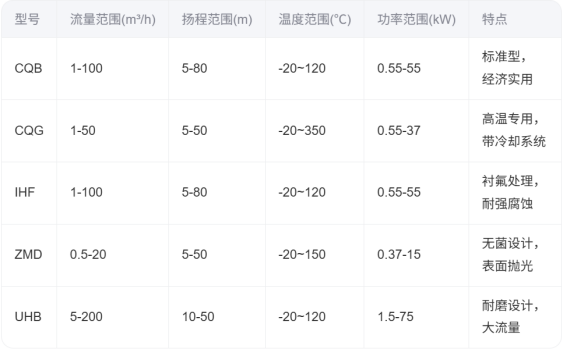Stainless steel high temperature magnetic pumps (high temperature magnetic pumps, corrosion resistant magnetic pumps) are widely used in chemical, pharmaceutical, electroplating and other industries. Their leak-free, high temperature and corrosion resistant characteristics make them an ideal choice for conveying hazardous media. This article provides a detailed magnetic pump selection guide, covering the comparison of pump types under different working conditions (such as high temperature, strong acid, and medium containing particles).
1. Pump type selection under different media and temperature conditions [Stainless steel magnetic pump, chemical pump selection]
Stainless steel high-temperature magnetic pumps are widely used in chemical, pharmaceutical, electroplating and other industries due to their excellent corrosion resistance and high temperature resistance. For different working conditions and media, the following factors should be considered when selecting:
①. Medium characteristic selection [acid and alkali resistant pump, high-temperature medium transportation]
·Corrosive media: Select 316L or 904L stainless steel material, 904L has better tolerance to strong acids and alkalis.
·High-temperature media: Standard type can be selected below 200℃, and high-temperature special type needs to be selected for 200-350℃.
·Particle-containing media: Standard type can be selected for particle content <5%, wear-resistant type or larger gap design needs to be selected for >5%.
·Easy to crystallize media: Models with insulation jackets should be selected to prevent the medium from crystallizing in the pump.
②. Comparison of working conditions of magnetic drive pump and leakage-free pump

2. Detailed explanation of technical parameters of mainstream models [Magnetic pump parameters Pump performance curve]
①. Models and parameters of chemical pumps such as CQB and IHF

②. Key performance parameters
·Flow rate: Select according to process requirements, it is recommended to leave a 10-15% margin
·Lift: Consider pipeline loss and vertical lifting height
·Temperature: The actual working temperature should be lower than the rated temperature of the pump by more than 20°C
·Power: Adjust according to the specific gravity and viscosity of the medium, high viscosity medium requires increased power.
3. Professional selection steps and usage suggestions
①. Five-step selection method
· Clearly define the characteristics of the medium: including composition, concentration, temperature, viscosity, particle content, etc.
· Determine process parameters: flow, head, inlet and outlet pressure, etc.
· Select materials: Select the appropriate stainless steel grade according to the corrosiveness of the medium
· Consider special needs: such as explosion-proof, aseptic, wear-resistant and other special requirements
· Check supporting equipment: motor power, cooling system, control system, etc.
②. Key points for the use and maintenance of magnetic pumps
· Installation: Ensure that the inlet has sufficient net positive suction head (NPSHa)
· Before starting: The pump must be primed and dry operation is strictly prohibited
· During operation: Monitor the bearing temperature, which should not exceed the ambient temperature +70℃
· Shutdown maintenance: The medium should be drained for long-term shutdown to prevent crystallization or corrosion

③. Common selection errors
· Ignoring the impact of medium temperature changes on pump performance
· Underestimating the pipeline resistance and resulting in insufficient head
· Ignoring the correction of medium viscosity to pump performance
· Selecting too large a safety margin leads to energy waste
Through the above guidelines, users can choose the most suitable stainless steel high-temperature magnetic pump model according to specific working conditions and medium characteristics to ensure long-term stable operation of the equipment and improve production efficiency. It is recommended to consult professional technicians or pump manufacturers before the final selection to obtain more accurate selection suggestions.

